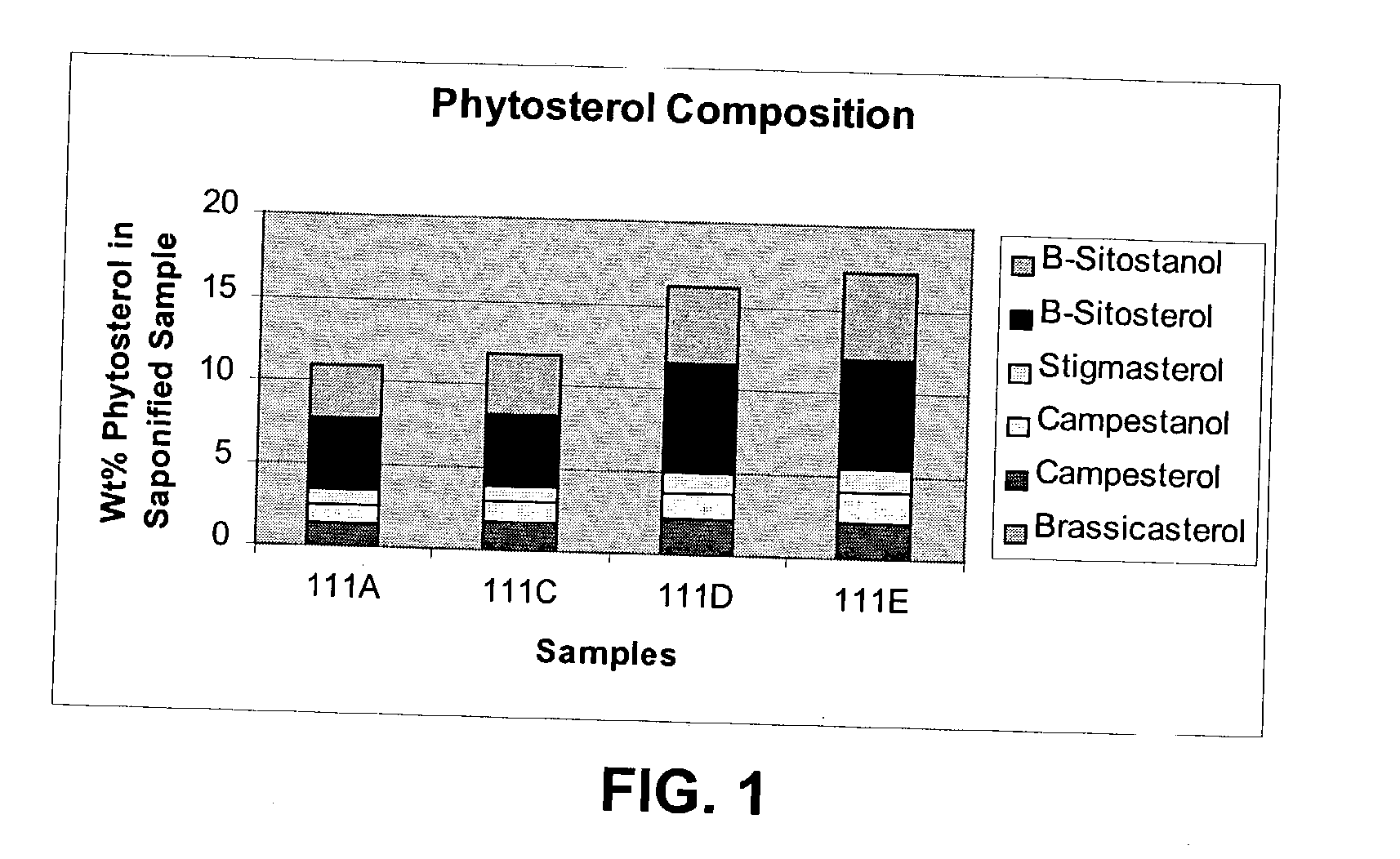Extraction of phytosterols from corn fiber using green solvents
a technology of corn fiber and solvents, which is applied in the direction of plant/algae/fungi/lichens, biocide, and separation processes, etc., can solve the problems of artherosclerosis or clogged arteries, heart attack, and only a tiny portion of the daily cholesterol intake of an average american, so as to improve the economics of corn wet milling and achieve the effect of improving the percentage of total sterols, energy cost saving, and improving the economics
- Summary
- Abstract
- Description
- Claims
- Application Information
AI Technical Summary
Benefits of technology
Problems solved by technology
Method used
Image
Examples
example 1
Solvent Study
[0036] This study compared solvents for selective extraction of phytosterols from corn fiber and was monitored by thin layer chromatography (TLC) using 95:5:1 (v / v / v) hexanes:isopropanol:acetic acid on silica gel with an acidic ferric chloride dip that, after heating, assists in visually detecting sterols and other lipid components. Sterols (St), steryl ferulates (St-F) and sterol fatty acid esters (St-FA) have a 0.1 mg detection limit, while the detection limit for free fatty acids (FFA) is 100 mg in this methodology.
[0037] Dry, ground, destarched corn fiber (DCF; .about.4 g) was placed in six glass screwcap tubes. The solvent (40 mL) indicated in Table 1 was placed in the tube with the DCF. The tubes were incubated at 25.degree. C. for 1 hour and 42.degree. C. for 1 hour with agitation (200 rpm). Extracts were removed by filtration and the solvent was evaporated under reduced pressure. TLC was completed on these samples with standards present on the same plate.
1TABLE ...
example 2
Ethanol / Water Selectivity Study
[0039] This experiment was designed to investigate phytosterol extraction using different concentrations of water in ethanol.
[0040] Dry, ground, DCF (.about.8 g) was placed in Erlenmeyer flasks with 80 mL of ethanol / water. Each flask had a different ethanol / water mixture. The samples were immersed in the extractant for 2 hours at 25.degree. C. and were extracted at 42.degree. C. for two additional hours without agitation. The samples were filtered, and the solvent was removed by vacuum distillation, and desiccated. The lipid contents of these samples are described in Tables 2 and 3.
2TABLE 2 A preliminary study of the relationship between water content and the ethanol extractable lipid components in DCF. % TLC Observations (most abundant Sample Solvent Water to least abundant lipids) 80A-4195 Ethanol 5 TAG, FFA, St, St-F, St-FA 80B-4195 Ethanol 10 TAG, FFA, St, St-F, St-FA 80C-4195 Ethanol 15 TAG, FFA, St, St-F, St-FA 80D-4195 Ethanol 20 FFA, St, St-F, ...
example 3
Agitated Batch Extraction of DCF with Ethanol / Water
[0046] Since the DCF is not ground, extraction efficiency was lower than anticipated for complete corn fiber oil extraction. Agitation is one way to increase extraction efficiency. For this series of pilot-scale experiments, a Microferm fermentor was used.
[0047] A. Using 80 / 20 Ethanol / Water
[0048] Sample #37-4233AR was prepared by extracting 750 g of dry DCF at 50.degree. C. with 80 / 20 ethanol / water by stirring (500 rpm) in a Microferm fermentor for two hours. The material was vacuum filtered while hot to remove the solids. The extract was saponified using 10% wt / v KOH for two hours at 50.degree. C. The saponification reaction was quenched with concentrated HCl to .about.pH1 and the volume was reduced by simple vacuum distillation. Hexane extraction of the concentrated extract left many of the impurities behind resulting in a 2.1% wt sample / wt of original DCF, but only a 24% recovery of material after saponification. Sample #37-4233A...
PUM
 Login to View More
Login to View More Abstract
Description
Claims
Application Information
 Login to View More
Login to View More - R&D
- Intellectual Property
- Life Sciences
- Materials
- Tech Scout
- Unparalleled Data Quality
- Higher Quality Content
- 60% Fewer Hallucinations
Browse by: Latest US Patents, China's latest patents, Technical Efficacy Thesaurus, Application Domain, Technology Topic, Popular Technical Reports.
© 2025 PatSnap. All rights reserved.Legal|Privacy policy|Modern Slavery Act Transparency Statement|Sitemap|About US| Contact US: help@patsnap.com

